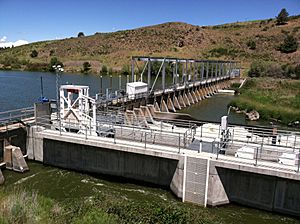Link River Dam facts for kids
Quick facts for kids Link River Dam |
|
|---|---|

The Link River Dam complex
|
|
| Location | Klamath Falls, U.S. |
| Coordinates | 42°14′02″N 121°48′07″W / 42.23389°N 121.80194°W |
| Construction began | July 29, 1920 |
| Opening date | October 29, 1921 |
| Owner(s) | U.S. Bureau of Reclamation |
| Dam and spillways | |
| Type of dam | Gravity dam |
| Impounds | Link River |
| Height | 7 m (23 ft) |
| Length | 113 m (371 ft) |
| Spillway capacity | 85 m3/s (3,002 cu ft/s) |
| Reservoir | |
| Creates | Klamath Lake |
| Total capacity | 1.1 km3 (890,000 acre⋅ft) |
| Maximum water depth | 18 m (59 ft) |
| Power station | |
| Turbines | 2 |
| Installed capacity | 151 MW |
The Link River Dam is a concrete dam located on the Link River in Klamath Falls, Oregon, U.S.. It was built in 1921 by a company called California Oregon Power Company (COPCO). Today, another company called PacifiCorp operates the dam. However, the dam is actually owned by the U.S. Bureau of Reclamation, a government agency.
The dam creates a large lake called Klamath Lake, which holds a lot of water. This water is super important for many things. It helps control floods, makes electricity, and stores water for farms in the Klamath Reclamation Project. The dam is about 7 meters (22 feet) tall and 133 meters (435 feet) long.
The Link River Dam has two main channels that let water flow out. These channels send water to PacifiCorp's two power generators downstream. These generators use the flowing water to create 151 megawatts of hydroelectric power. All the water eventually flows into Lake Ewauna.
In 2004, PacifiCorp said they might stop using the Link River for power. This was because it would cost too much to fix the canals and pipes. But as of 2014, they decided to keep the power plant running for a while, even if it makes less electricity.
History of the Link River Dam
Long ago, in 1878, people living in a town called Linkville (which is now Klamath Falls) started a company to dig a small canal. This canal connected their homes to the Link River. A man named William Steele made the ditch longer in 1884. After he passed away, another company took over the canal. Today, it's known as the Ankeny Canal.
On the other side of the Link River, in 1877, two brothers, Charles and Rufus Moore, dug another canal. They used it to power a sawmill and move logs from Upper Klamath Lake. This canal later became known as the Keno Canal.
In 1917, the U.S. Bureau of Reclamation and COPCO made a deal. COPCO could use the Keno Canal for ten years and also control how much water flowed out of Klamath Lake. In 1919, COPCO built a temporary dam. Then, on July 29, 1920, construction officially began on the permanent Link River Dam.
A government official named George E. Chamberlain, who was a Senator from Oregon, asked to stop the dam's construction for a bit. He wanted to check if the 1917 agreement was legal. After some discussions, a new agreement was made in December 1920. Construction started again in May 1921 and the dam was finished on October 29, 1921.
Current Operations and Future Plans
A 50-year contract between the U.S. Bureau of Reclamation and PacifiCorp ended in 2006. PacifiCorp suggested stopping the power generation at Link River. They said it was too expensive to make changes needed to help fish pass safely. This plan would have kept the dam for water storage and flood control only.
As of 2014, PacifiCorp plans to keep making electricity at Link River for now, but at a lower level. They have made changes to help protect two endangered species of fish: the Lost River sucker and the Shortnose sucker. These changes are meant to reduce harm to these fish by about 90%. Discussions about the dam's future are still ongoing with the government agency that regulates energy, the Federal Energy Regulatory Commission.


